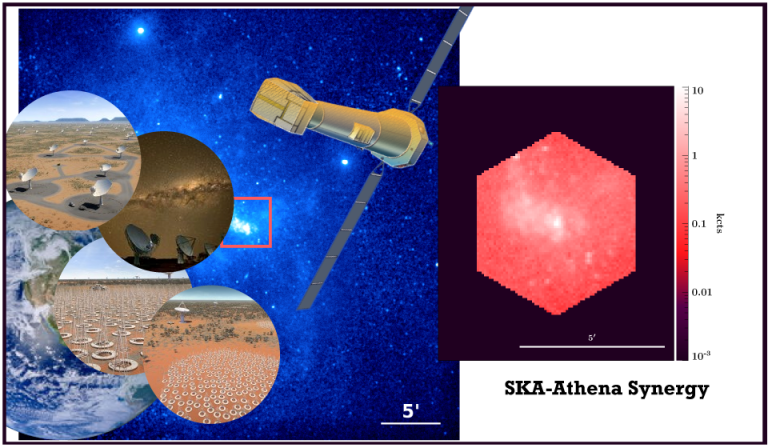SKA-Athena Synergy White Paper released

The SKA-Athena Synergy White Paper highlights the areas of science where combining data gathered by the two facilities would provide unique insights that would not be available with data from the individual telescopes themselves.
Athena (Advanced Telescope for High ENergy Astrophysics) will be a space-based X-ray telescope that aims to investigate the “Hot and Energetic Universe” scientific theme, and it is provisionally due to be launched in the early 2030s – making it an ideal contemporary instrument to the SKA. It is one of a number of facilities with which the SKA is exploring possible synergies, with the goal of supporting the wider astronomy community to make discoveries through collaborations across the electromagnetic spectrum.
The white paper was authored by the SKA-Athena Synergy Team, a group of experts based at four leading research organisations: Dr Rossella Cassano (INAF-Istituto di Radioastronomia, Italy), Dr Rob Fender (University of Oxford, UK), Dr Chiara Ferrari (Observatoire de la Côte d’Azur, France) and Dr Andrea Merloni (Max-Planck Institute for Extraterrestrial Physics, Germany), based on contributions from 25 scientists in eleven different countries.
“While there are many areas of synergy, one of the most exciting is the pin-pointing of the very first generation of stars to have been born in the Universe,” said SKA Organisation Science Director Dr Robert Braun. “The SKA should allow detection of the ionised bubbles surrounding these stars as cavities within the neutral hydrogen emission at the relevant epoch, while Athena would permit direct detection of the ionising sources themselves.”
Another important area is in understanding the growth and evolution of super-massive black holes, like the one at the centre of our own Milky Way Galaxy. “The two-pronged radio/X-ray approach is particularly well-matched to the study of these enigmatic objects that are found to reside at the centre of most major galaxies,” Dr Braun added. “While they tend to be particularly bright in the X-ray and radio bands, they tend to be almost invisible in the intervening portions of the electromagnetic spectrum due to the extreme gravitational forces and very high temperatures.”
Next year the SKA Organisation Global Headquarters at Jodrell Bank in the UK will host the SKA General Science Meeting, a major gathering of the international science community interested in the project. Many of the synergies outlined in the white paper will be further discussed there.
To read the full SKA-Athena Synergy White Paper, download a PDF copy here.




